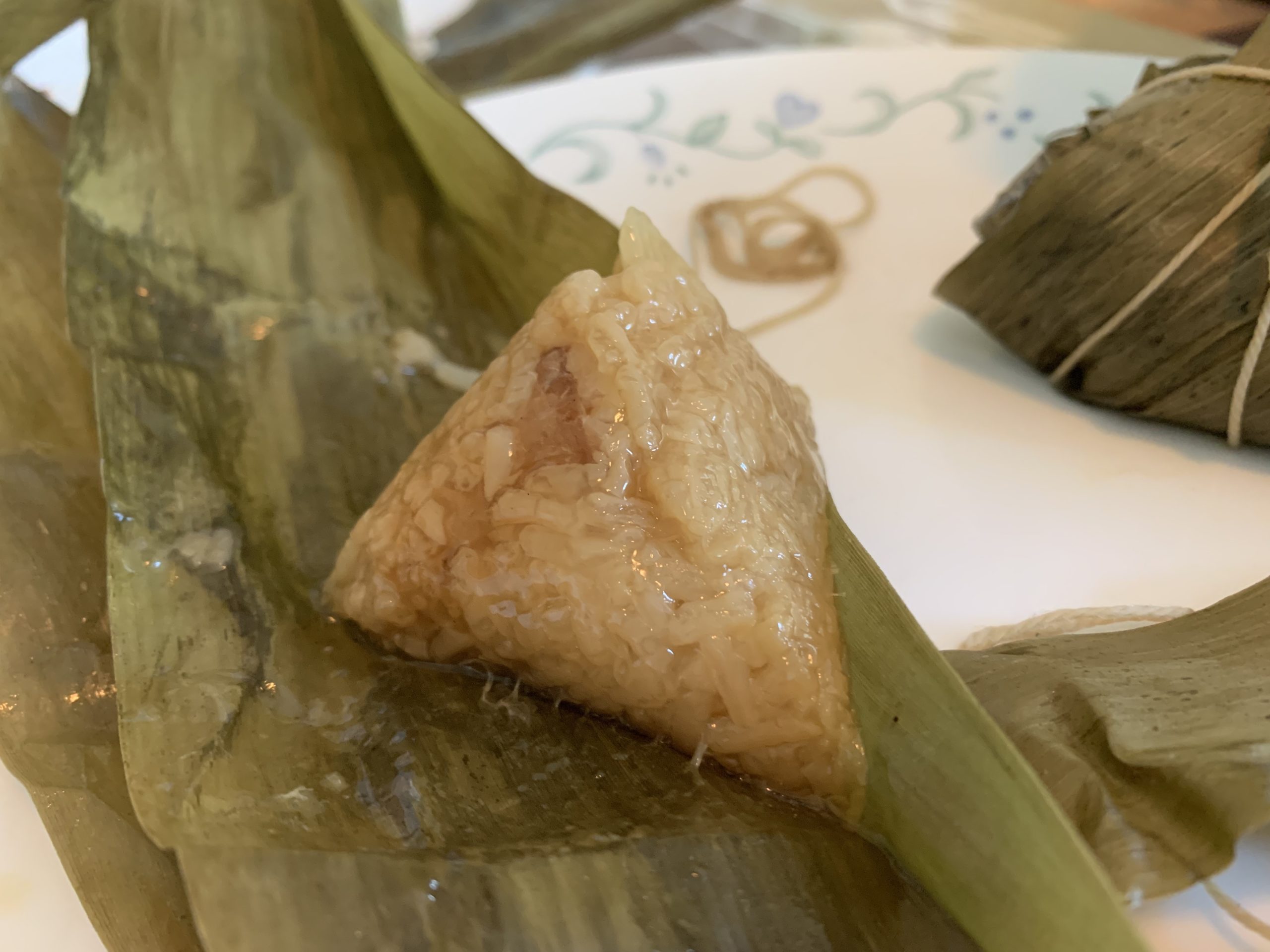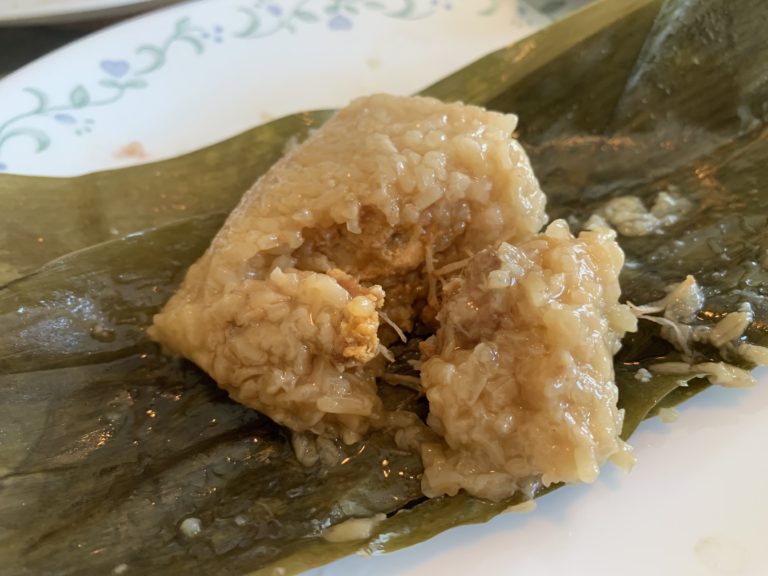In a couple days, it will be 端午节 (duān wǔ jié) or the Dragon Boat Festival. As we’ve learned in our last article, eating the traditional treat 粽子 (zòng zi), or zongzi is an important custom of this Chinese holiday.
Back in Shanghai, my mom and I would always buy some pre-made at the nearest supermarket. But in America, zongzi are much harder to find, especially if you don’t live near a Chinatown.
This was when my legendary aunt called and said: “Why buy them? I make them myself every year, come and help me out!”
 Our end product!
Our end product!
So we did! Follow along to see the successes, slip-ups, and most importantly, the fun we had in making our very own zongzi!
Preparation
As we know, there are two types of zongzi, salty and sweet. Our family loves both, so we prepared ingredients for a salty meat zongzi, and a sweet red-bean zongzi.
These are the flavors we chose, but feel free to choose your own!

Ingredients for ~15 zongzi in each flavor:
Sweet:
30 reed/bamboo leaves
Glutinous rice (500 g)
One small bag of red bean paste (around 200 g)
15 pieces of cut string
Salty:
30 reed/bamboo leaves
Glutinous rice (500 g)
Fatty/streaky pork (500 g)
7-8 salted duck eggs
Shelled mung beans (100 g)
15 pieces of cut string
1. REED/BAMBOO LEAVES
Video of us washing the bamboo leaves
 Click the link above to see a video of my mom washing bamboo leaves!
Click the link above to see a video of my mom washing bamboo leaves!
So first off, the leaves! We were able to buy our bamboo leaves at a large Chinese supermarket pretty easily. They were displayed right next to the front door.
Try your luck at larger stores, there’s a better chance they’ll have it!
To prepare the leaves, put them in a pot of water overnight. My aunt left them in for an extra morning, but one night should soften them up.
Right before you begin making your zongzi, be sure to wash your leaves one by one. These leaves will be going right up against our food, so we want to make sure they are clean.
 See how pretty they are?
See how pretty they are?
2. GLUTINOUS RICE
Our glutinous rice was again bought at a Chinese supermarket. There will be many brands and packaging, but as long as it’s glutinous rice, you’ll be ok.
Because we wanted to make two flavors, we prepared two bowls of rice, one for the sweet and one for the salty. Remember that the rice we use here will be raw!
We’ll cook it all together at the end when we boil the zongzi.
 This is the rice for the sweet zongzi. The rice for the salty one will look yellow after you add soy sauce
This is the rice for the sweet zongzi. The rice for the salty one will look yellow after you add soy sauce
The rice for the sweet zongzi can remain as is, straight from the packet. The rice for the salty zongzi, however, needs some preparation.
Put in some oil and soy sauce to give it a salty flavor. In the video, we put in both thin soy-sauce (生抽) and thick soy-sauce (老抽).
If that confuses you, just put in whatever soy-sauce you have on the shelf. It most likely will work just fine!
3. FATTY PORK
 What the pork looks like when we took it out the next morning
What the pork looks like when we took it out the next morning
For people who like a little more oil in their zongzi (like us!), pick a cut of meat streaked with fat at the counter. If you’d prefer lean meat, however, or even beef or lamb, feel free to choose something else.
To make zongzi, the meat needs to be marinated overnight. The night before, cut up the meat into small chunks and put them in a bowl.
Add soy sauce (thin and thick), a bit of oyster sauce, some sesame oil, a sprinkle of black pepper, and cut-up scallions and ginger.
Remember to refrigerate it for the night, or it will go bad!
4. MARINATED DUCK EGGS
 The duck eggs we bought. Some places sell the yolk on its own, but we found that those tend to taste worse because it's been dried
The duck eggs we bought. Some places sell the yolk on its own, but we found that those tend to taste worse because it's been dried
Usually in zongzi, we only put in the yolk and not the egg white. After buying some marinated duck eggs, shell them and take out the yolks.
Don’t worry—you can use the egg whites in other dishes. We put ours in our ramen, but there are many options!
 It takes a while to split the egg white from the yolk, and nearly impossible not to break the yolk in the process, but that's ok!
It takes a while to split the egg white from the yolk, and nearly impossible not to break the yolk in the process, but that's ok!
5. RED BEAN PASTE AND MUNG BEANS
These don’t need special preparation—just put your store-bought red bean paste into a bowl.
We decided to add some shelled mung beans to our salty zongzi, but feel free to add whatever you would like.
Making the Zongzi
To see my video tutorial of how to make zongzi, click the link!
Simply put, though, first take two leaves and cut off the ends. Fold them in half vertically, then fold one end up to the one-third mark.
Open the leaves from the middle to create the point in which you’ll put your ingredients in.

Next, put in some glutinous rice. Follow up with the filling of your choice, and top it off with more rice.
Make sure to pinch the front of the triangle we’ve made with our leaves when you fold the remaining two-thirds of the leaves down.

Fold the remaining portion of the leaves along the triangular fold and tie with string. Make sure to wrap the string around all corners before tying a double knot on top.
Boiling the Zongzi
Now, we boil! Heat up a pot of water and wait until it boils. Then, throw in the zongzi (wrapped up with leaves and string).
Wait for two full hours before taking them out.
 Before boiling
Before boiling
Some people will prefer to steam their zongzi, in which case you put the water at the bottom of the pot and lay the zongzi on top of the metal steamer. If you go with steaming, the zongzi and the water don't touch.
Unwrap it and enjoy!
 Close to the two hour mark
Close to the two hour mark
Last Words
When I first started making my zongzi, they always came out in odd shapes. My aunt’s pro-tip®, however, was to pinch the front of the leaves to create the triangular shape in the pyramid.
I found this super helpful and my shapes got better and better with practice.
 Remember to give it the pinch!
Remember to give it the pinch!
If you are still having trouble making the pyramid shape, don’t worry. The zongzi will taste just as good, trust me.
Even if you decide to roll your zongzi into a sushi, as long as it’s firmly sealed with string, it will still turn out great!
What really struck me was how good these things tasted. They were honestly better than any store-bought zongzi I’ve ever had, because the ingredients were so fresh.
Since we used fresh pork instead of the traditional cured meat, it was extra juicy and just absolutely delicious.
 It tasted so good!
It tasted so good!
I hope you guys found this recipe easy enough to follow and happy Dragon Boat Festival!



0 Comments